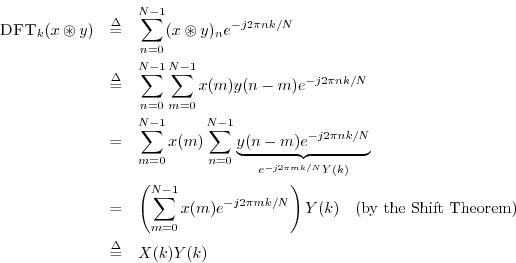Convolution Theorem
Theorem: For any
![]() ,
,
Proof:

This is perhaps the most important single Fourier theorem of all. It
is the basis of a large number of FFT applications. Since an FFT
provides a fast Fourier transform, it also provides fast
convolution, thanks to the convolution theorem. It turns out that
using an FFT to perform convolution is really more efficient in
practice only for reasonably long convolutions, such as ![]() . For
much longer convolutions, the savings become enormous compared with
``direct'' convolution. This happens because direct convolution
requires on the order of
. For
much longer convolutions, the savings become enormous compared with
``direct'' convolution. This happens because direct convolution
requires on the order of ![]() operations (multiplications and
additions), while FFT-based convolution requires on the order of
operations (multiplications and
additions), while FFT-based convolution requires on the order of
![]() operations, where
operations, where ![]() denotes the logarithm-base-2 of
denotes the logarithm-base-2 of
![]() (see §A.1.2 for an explanation).
(see §A.1.2 for an explanation).
The simple matlab example in Fig.7.13 illustrates how much faster
convolution can be performed using an FFT.7.16 We see that
for a length ![]() convolution, the fft function is
approximately 300 times faster in Octave, and 30 times faster in
Matlab. (The conv routine is much faster in Matlab, even
though it is a built-in function in both cases.)
convolution, the fft function is
approximately 300 times faster in Octave, and 30 times faster in
Matlab. (The conv routine is much faster in Matlab, even
though it is a built-in function in both cases.)
N = 1024; % FFT much faster at this length t = 0:N-1; % [0,1,2,...,N-1] h = exp(-t); % filter impulse reponse H = fft(h); % filter frequency response x = ones(1,N); % input = dc (any signal will do) Nrep = 100; % number of trials to average t0 = clock; % latch the current time for i=1:Nrep, y = conv(x,h); end % Direct convolution t1 = etime(clock,t0)*1000; % elapsed time in msec t0 = clock; for i=1:Nrep, y = ifft(fft(x) .* H); end % FFT convolution t2 = etime(clock,t0)*1000; disp(sprintf([... 'Average direct-convolution time = %0.2f msec\n',... 'Average FFT-convolution time = %0.2f msec\n',... 'Ratio = %0.2f (Direct/FFT)'],... t1/Nrep,t2/Nrep,t1/t2)); % =================== EXAMPLE RESULTS =================== Octave: Average direct-convolution time = 69.49 msec Average FFT-convolution time = 0.23 msec Ratio = 296.40 (Direct/FFT) Matlab: Average direct-convolution time = 15.73 msec Average FFT-convolution time = 0.50 msec Ratio = 31.46 (Direct/FFT) |
A similar program produced the results for different FFT lengths shown
in Table 7.1.7.17 In this software environment, the fft function
is faster starting with length ![]() , and it is never significantly
slower at short lengths, where ``calling overhead'' dominates.
, and it is never significantly
slower at short lengths, where ``calling overhead'' dominates.
|
A table similar to Table 7.1 in Strum and Kirk
[79, p. 521], based on the number of real
multiplies, finds that the fft is faster starting at length ![]() ,
and that direct convolution is significantly faster for very short
convolutions (e.g., 16 operations for a direct length-4 convolution,
versus 176 for the fft function).
,
and that direct convolution is significantly faster for very short
convolutions (e.g., 16 operations for a direct length-4 convolution,
versus 176 for the fft function).
See Appendix A for further discussion of FFT algorithms and their applications.
Next Section:
Dual of the Convolution Theorem
Previous Section:
Shift Theorem



















